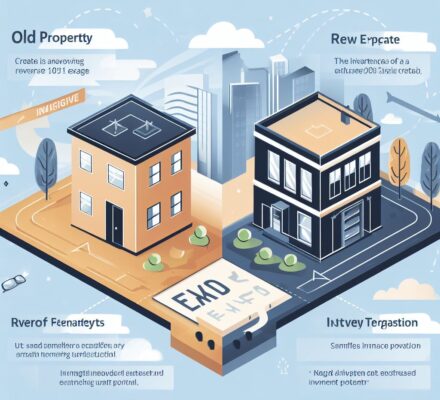Are you looking for a way to maximize your tax benefits and gain more flexibility in your investment strategy? Look no further than a reverse 1031 exchange.
By utilizing this powerful exit strategy, you can defer taxes, seize greater investment opportunities, and smoothly transition between properties.
With the potential for higher returns and a streamlined process, a reverse 1031 exchange is a game-changer for savvy investors like yourself.
Key Takeaways
- Powerful tool to defer capital gains taxes
- Increased flexibility and investment opportunities
- Potential for higher returns
- Streamlined property transitions
Tax Deferral
To maximize your tax benefits, consider utilizing a reverse 1031 exchange to defer taxes on your real estate transactions. A reverse 1031 exchange is a powerful tool that allows you to defer capital gains taxes by exchanging properties. Unlike a traditional 1031 exchange, where you sell your property first and then identify and acquire a replacement property, a reverse 1031 exchange allows you to acquire the replacement property first and then sell your existing property within a specified time frame.
The main advantage of a reverse 1031 exchange is the ability to defer taxes on the sale of your property. By utilizing this strategy, you can potentially save a substantial amount of money that would have otherwise gone towards paying capital gains taxes. This tax deferral can free up cash flow that you can use for other investments or expenses.
Additionally, a reverse 1031 exchange provides flexibility and allows you to take advantage of market opportunities. You can strategically acquire a replacement property before selling your existing property, which gives you the advantage of being able to negotiate better terms and prices. This flexibility can be particularly beneficial in a competitive real estate market where finding suitable replacement properties can be challenging.
Increased Flexibility
With increased flexibility, you can strategically acquire a replacement property before selling your existing property in a reverse 1031 exchange. This allows you to take advantage of market opportunities and potentially secure a more desirable property without the pressure of a tight timeline. Here are four reasons why increased flexibility is advantageous in a reverse 1031 exchange:
- Market Timing: By acquiring a replacement property before selling your existing property, you can take advantage of favorable market conditions. This allows you to potentially secure a property at a lower price or in a more desirable location.
- Property Selection: With increased flexibility, you have the freedom to thoroughly evaluate and select the replacement property that best aligns with your investment goals. This can lead to better long-term returns and overall satisfaction with your investment.
- Negotiating Power: Acquiring a replacement property before selling your existing property puts you in a stronger negotiating position. You have the ability to negotiate from a position of strength, potentially securing more favorable terms and conditions.
- Reduced Stress: By giving yourself ample time to acquire a replacement property, you can reduce the stress associated with finding a suitable property within a tight timeframe. This allows for a more thoughtful and well-planned approach to your investment strategy.
With increased flexibility in a reverse 1031 exchange, you have the opportunity to strategically acquire a replacement property, potentially taking advantage of market opportunities and securing a property that aligns with your investment goals. This sets the stage for greater investment opportunities in the next section.
Greater Investment Opportunities
You can capitalize on the increased flexibility of a reverse 1031 exchange to explore greater investment opportunities and maximize your returns. By utilizing this strategy, you have the ability to acquire properties that may not have been previously available to you due to financial constraints or timing issues. This opens up a whole new realm of possibilities for diversifying your investment portfolio and potentially increasing your overall profitability.
One advantage of a reverse 1031 exchange is the ability to acquire a replacement property before selling your relinquished property. This allows you to take advantage of market opportunities and secure properties that align with your investment goals. Additionally, the reverse 1031 exchange provides the opportunity to consolidate multiple properties into a single replacement property, streamlining your portfolio and potentially increasing efficiency.
To illustrate the potential investment opportunities, consider the following table:
| Investment Opportunities | Advantages |
|---|---|
| Acquiring properties in high-growth areas | Potential for significant appreciation |
| Diversifying your portfolio across different asset classes | Reduced risk through diversification |
| Investing in properties with higher cash flow potential | Increased passive income |
| Accessing properties with value-add potential | Ability to create equity through improvements |
Potential for Higher Returns
By utilizing a reverse 1031 exchange, you can potentially achieve higher returns on your investments. This exit strategy allows you to defer capital gains taxes by acquiring replacement property before selling your existing property.
Here are four reasons why a reverse 1031 exchange can lead to higher returns:
- Timing: With a reverse 1031 exchange, you have the advantage of acquiring replacement property first. This allows you to take advantage of favorable market conditions and potentially purchase property at a lower price. By securing the replacement property before selling, you can potentially maximize your returns.
- Property Upgrades: When using a reverse 1031 exchange, you have the opportunity to invest in a property that offers higher rental income or appreciation potential. By upgrading to a more lucrative property, you can significantly increase your returns over time.
- Tax Savings: By deferring the capital gains tax, you can reinvest those funds into the replacement property. This additional capital can be used to improve the property, attract higher-paying tenants, or make other strategic investments that can further enhance your returns.
- Diversification: A reverse 1031 exchange allows you to diversify your investment portfolio by acquiring different types of properties or properties in different locations. This diversification can help mitigate risks and potentially enhance your overall returns.
Streamlined Property Transitions
To ensure a smooth transition of properties, a reverse 1031 exchange offers a streamlined process for investors. This type of exchange allows investors to acquire a replacement property before selling their current property, allowing for a seamless transfer of assets. By using this strategy, investors can avoid the pressure of finding a replacement property within a limited timeframe, which is a requirement in a traditional 1031 exchange.
In a reverse 1031 exchange, the investor first acquires the replacement property through a qualified intermediary. The intermediary holds the title to the replacement property until the investor sells their relinquished property. This allows for a simplified and efficient transfer of properties, minimizing any potential delays or complications.
Additionally, a reverse 1031 exchange provides investors with greater flexibility in choosing the replacement property. Without the time constraint of a traditional 1031 exchange, investors can thoroughly evaluate various investment opportunities and make informed decisions that align with their long-term goals.
Moreover, the streamlined process of a reverse 1031 exchange reduces the risk of missed opportunities. Investors can immediately take advantage of favorable market conditions, without having to wait for their current property to sell. This increases the likelihood of securing a desirable replacement property and maximizing investment returns.
Frequently Asked Questions
Can a Reverse 1031 Exchange Be Used for Personal Properties or Is It Limited to Investment Properties?
Yes, a reverse 1031 exchange can be used for personal properties as well as investment properties. It provides the advantage of deferring taxes on the sale of a property by allowing you to acquire a replacement property first.
Are There Any Specific Time Limitations or Deadlines to Complete a Reverse 1031 Exchange?
To complete a reverse 1031 exchange, there are specific time limitations and deadlines you need to be aware of. These requirements ensure that the transaction is done within the IRS guidelines.
How Does the IRS View Reverse 1031 Exchanges and What Are the Potential Tax Implications?
The IRS views reverse 1031 exchanges as legitimate transactions, but there may be potential tax implications. It’s important to consult with a tax professional to fully understand the specific implications for your situation.
Are There Any Restrictions on the Types of Properties That Can Be Exchanged Using a Reverse 1031 Exchange?
There are no restrictions on the types of properties that can be exchanged using a reverse 1031 exchange. This allows you to have more flexibility in choosing the property that best suits your investment needs.
What Are the Potential Risks or Downsides of Utilizing a Reverse 1031 Exchange as an Exit Strategy?
Potential risks or downsides of utilizing a reverse 1031 exchange as an exit strategy include the complexity of the process, the need for sufficient funds, and the possibility of not finding a suitable replacement property within the designated time frame.




